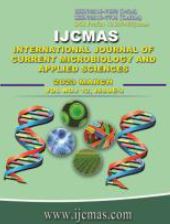


 National Academy of Agricultural Sciences (NAAS)
National Academy of Agricultural Sciences (NAAS)

|
PRINT ISSN : 2319-7692
Online ISSN : 2319-7706 Issues : 12 per year Publisher : Excellent Publishers Email : editorijcmas@gmail.com / submit@ijcmas.com Editor-in-chief: Dr.M.Prakash Index Copernicus ICV 2018: 95.39 NAAS RATING 2020: 5.38 |
A field experiment was carried out during cropping seasons of 2021-22 and 2022-23 at the Private Research Farm, Beenda-Semaria road, Rewa (M.P.) to study the variation in chlorophyll content and growth and yield of short-duration pigeonpea genotypes applied with phosphorus and sulphur. The chlorophyll content in leaves was found to increase between 60 and 120 DAS growth period, thereafter it tended to decline up to at 150 DAS stage. It was the general trend irrespective of the applied treatments. Amongst the genotypes, TJT-501 recorded also significantly higher chlorophyll formation at different stages over other genotypes. Chlorophyll was 3.91 and 3.49 mg/g at 120 and 150 DAS under TJT-501 as against 3.32 and 2.94 mg/g, respectively in case of ICPL-87. The genotype IJPAS-120 proved the second best genotype to produce incised chlorophyll. Consequently the growth (plant height, branches, leaves/plant and dry matter) and yield of both these genotypes were increased in the same order. The seed and straw yield from TJT-501 was recorded up to 12.15 and 45.49 q/ha, respectively. The harvest index (HI) was 21.20%. Similarly the P60 S45 recorded maximum chlorophyll content, growth parameters, seed and straw yield of pigeonpea. The seed and straw yield under P60 S45 was 12.94 and 57.70 q/ha, respectively. The HI was 21.98%.
 |
 |
 |
 |
 |